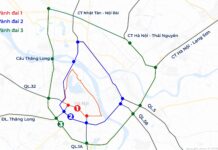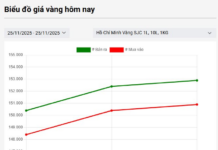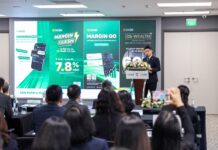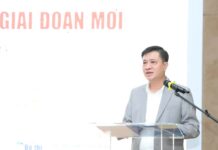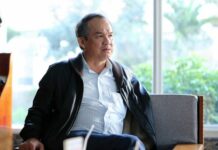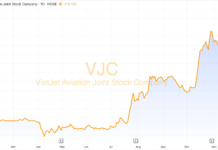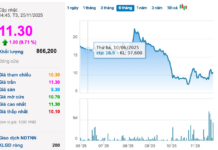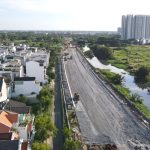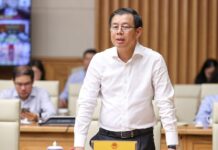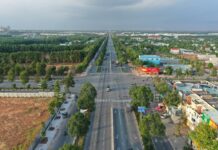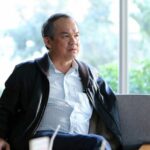“Hanoi’s Grand Ambition”
As the gateway province to the south of the capital, Hanoi, and located within the economic development quadrangle of northern Vietnam, including Quang Ninh, Hai Phong, Hanoi, and Thanh Hoa, Hanoi enjoys exceptional connectivity advantages with easy access to vital transport routes. The province is envisioned to become a satellite city with an anticipated high growth rate.
 Hanoi is strategically located south of Hanoi and boasts well-connected transportation links.
|
Hanoi boasts a transportation infrastructure seamlessly connected to National Highway 1A, the Phap Van-Cau Gie-Ninh Binh Expressway, and the upcoming North-South high-speed railway. The Phu Thu 3-layer interchange, which is under construction, will connect to the Ring Road 5 of the Capital Region, significantly reducing travel time to Hanoi and other key northern provinces. This will make traveling from Hanoi to other provinces as quick as commuting from the city center to neighboring districts and towns.
In terms of intrinsic development indices, Hanoi currently has one of the fastest urban growth rates in the Red River Delta region and ranks fourth among 11 provinces in the Red River Delta in terms of urbanization rate. With its solid foundation, Hanoi has set a goal to develop Phu Ly into a first-tier city by 2030. Notably, the Hanoi Provincial Planning for the period 2021–2030, with a vision towards 2050, approved by the Prime Minister, aims to elevate the province to a municipality directly under the Central Government by 2050 and aspires to become the industrial, commercial, and service center of the Red River Delta Region.
 Hanoi boasts a rich array of historical and cultural heritage sites, providing favorable conditions for tourism development.
|
According to the criteria for a municipality directly under the Central Government, the per capita income should be 1.75 times the national average, with a substantial contribution from the industry, construction, and service sectors, and a non-agricultural labor force in the inner city and towns reaching 90%. Statistics show that Hanoi’s current per capita income is VND 5.8 million per month, approximately 1.2 times the national average. However, the contribution of the industry, construction, and service sectors to the provincial economy stands at 64% and 23%, respectively, while the non-agricultural labor force accounts for around 80%. Therefore, to meet the standards of a municipality, Hanoi needs to focus on increasing per capita income and accelerating the shift from an agricultural economy to industry, construction, and, particularly, services.
The province is currently oriented towards expanding its urban space, developing a synchronous infrastructure system, and promoting sustainable urban development in tandem with commerce, services, and tourism. One of the most practical approaches to achieving a breakthrough in Hanoi’s economic development is to attract reputable and sizeable enterprises, as suggested by Dr. Tran Dinh Thien, former Director of the Vietnam Economics Institute.
“To turn advantages into competitive capabilities, we must attract businesses of the right caliber, creating strong magnets that will attract other investors and propel Hanoi forward,” emphasized Dr. Thien.
A Boost from Large-Scale Projects
In South Korea, Gyeonggi Province has been developed since the 1970s as a satellite city of Seoul. This has led to revolutionary advancements in transportation infrastructure, urban redevelopment, housing development, and, most notably, investment attraction. Today, Gyeonggi is South Korea’s most populous province, with balanced growth across heavy and light industries and agriculture. It is also home to the headquarters of major chaebols, including Samsung, LG, and SK. Gyeonggi has become a desirable destination for intellectuals and experts, offering abundant job opportunities and more affordable living and housing costs than the capital.
 Sun Urban City, a modern urban project, is expected to be a catalyst for Hanoi’s transformation.
|
With its inherent advantages, Hanoi has the potential to become Vietnam’s “Gyeonggi Province” if it can attract significant investors, just as Samsung, SK, and LG have invested billions of dollars in Gyeonggi over the years. One such prominent investor in Hanoi is Sun Group, with its large-scale project, Sun Urban City. This development is expected to be a catalyst for Hanoi’s transformation.
Spanning 420 hectares and with a total investment of VND 35,000 billion, Sun Urban City, or the Southern Hanoi Suburban Resort City with 1,001 Utilities, promises to bring a new look to Phu Ly with multiple objectives: building a civilized and modern urban area offering diverse amenities for its residents, and transforming the provincial economy from agriculture to industry and services. “Sun Urban City will be a project that will dramatically transform Phu Ly City and propel Hanoi to new heights, making it a desirable destination and a great place to live in Vietnam,” said Mr. Truong Quoc Huy, Deputy Secretary of the Provincial Party Committee and Chairman of the Provincial People’s Committee of Hanoi.
 Sun Urban City is Hanoi’s largest urban project, featuring world-class amenities.
|
As Hanoi’s most extensive urban project to date, Sun Urban City comprises five grand parks: a festival park, a cultural park, Sun World park, a sports park, and an ecological park. This will generate a massive demand for human resources, creating additional job opportunities and stable incomes for locals and those in neighboring provinces. Moreover, the sustainable revenue stream from Sun Urban City will significantly contribute to the provincial budget. According to Mr. Huy, these funds will be allocated to invest in transportation infrastructure, schools, hospitals, and other social amenities to enhance the quality of life for locals.
Looking at models like Gyeonggi in South Korea or satellite cities in India and China, it is evident that developing modern urban areas like Sun Urban City will create a worthy living environment to attract talented individuals and high-income earners. As the Telegraph (UK) points out, urban development translates to more job creation, a higher demand for skilled labor, smoother cash flow, and economic growth for the entire region.
With nearly two decades of experience in transforming destinations across Vietnam, from Lao Cai, Quang Ninh, Thanh Hoa, and Da Nang to Tay Ninh and Phu Quoc, Sun Group is once again expected to play a pivotal role in propelling Phu Ly and Hanoi towards becoming a municipality directly under the Central Government.
Hanoi’s Update on the Delayed 1.000 billion VND Hospital Project
To address the challenges faced by investors, the Hanoi People’s Committee has instructed the Long Bien People’s Committee and the Department of Natural Resources and Environment to resolve any obstacles that arise during the implementation of the Thang Long 1,000-Year Oncology and Plastic Surgery Hospital project.



